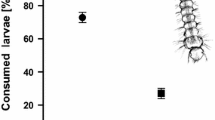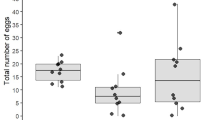Abstract
In the present study, the effect of chemical cues from two fish species (mosquitofish and pumpkinseed), at different concentrations, was tested in life history experiments with Daphnia longispina. The two fish species used represent the most abundant planktivores of many Mediterranean shallow lakes (SW Europe), where the indigenous fish communities have been replaced by such exotic assemblages. Results have shown a similar response of D. longispina to both fish species: kairomones stimulated daphnids to produce more offspring, which resulted in higher fitness (r), relatively to a fishless control. Fish presence also induced an earlier first reproduction, a smaller size at maturity of daphnids, and the production of smaller-sized neonates. Significant correlations with fish concentration (indirect measure of fish kairomone concentration) were found for size at maturity and neonate size, for both fish species. These results are in accordance to the “positive response” observed by other authors, which represents a defence mechanism to face losses caused by fish predators. The chemically mediated size reduction of mature females and neonates is an adaptive response to the size-selective predation exerted by fish. Pumpkinseed introduction is very recent in the lake of origin of the daphnids used in the experiments and its kairomone produced similar effects to mosquitofish in the life history of D. longispina. These results are contrary to the existence of a species-specific kairomone and support the hypothesis of a general fish kairomone.




Similar content being viewed by others
References
Almaça, C., 1995. Fish species and varieties introduced into Portuguese inland waters. Museu Nacional de História Natural, Lisboa.
Antunes, S. C., B. B. Castro & F. Gonçalves, 2003. Chronic responses of different clones of Daphnia longispina (field and ephippia) to different food levels. Acta Oecologica 24: S325–S332.
Baird, D. J., A. M. V. M. Soares, A. Girling, I. Barber, M. C. Bradley & P. Calow, 1989. The long-term maintenance of Daphnia magna Straus for use in ecotoxicity tests: problems and prospects. In Løkke, H., H. Tyle & F. Bro-Rasmussen (eds), Proceedings of the first European Conference on Ecotoxicology, SECOTOX. Technical University, Lyngby, Denmark, 144–148.
Billiones, R., M. Brehm, J. Klee & K. Schwenk, 2004. Genetic identification of Hyalodaphnia species and interspecific hybrids. Hydrobiologia 526: 43–53.
Blanco, S., S. Romo, M. J. Villena & S. Martínez, 2003. Fish communities and food web interactions in some shallow Mediterranean lakes. Hydrobiologia 506: 473–480.
Boersma, M., P. Spaak & L. De Meester, 1998. Predator-mediated plasticity in morphology, life history, and behavior of Daphnia: the uncoupling of responses. American Naturalist 152: 237–248.
Burks, R. L., E. Jeppesen & D. M. Lodge, 2000. Macrophyte and fish chemicals suppress Daphnia growth and alter life-history traits. Oikos 88: 139–147.
De Meester, L. & C. Cousyn, 1997. The change in phototactic behaviour of a Daphnia magna clone in the presence of fish kairomones: the effect of exposure time. Hydrobiologia 360: 169–175.
De Meester, L. & L. J. Weider, 1999. Depth selection behaviour, fish kairomones, and the life histories of Daphnia hyalina × galeata hybrid clones. Limnology and Oceanography 44: 1248–1258.
Dodson, S. I., 1988. The ecological role of chemical stimuli for the zooplankton: predator-avoidance behavior in Daphnia. Limnology and Oceanography 33: 1431–1439.
Engelmayer, A., 1995. Effects of predator-released chemicals on some life-history parameters of Daphnia pulex. Hydrobiologia 307: 203–206.
Enserink, L., W. Luttmer & H. Maas-Diepeveen, 1990. Reproductive strategy of Daphnia magna affects the sensitivity of its progeny in acute toxicity tests. Aquatic Toxicology 17: 15–26.
Garcia-Berthou, E. & R. Moreno-Amich, 2000. Introduction of exotic fish into a Mediterranean lake over a 90-year period. Archiv für Hydrobiologie 149: 271–284.
Giessler, S., E. Mader & K. Schwenk, 1999. Morphological evolution and genetic differentiation in Daphnia species complexes. Journal of Evolutionary Biology 12: 710–723.
Gliwicz, Z. M. & C. Guisande, 1992. Family planning in Daphnia: resistance to starvation in offspring born to mothers grown at different food levels. Oecologia 91: 463–467.
Hanazato, T., K. Fueki & M. Yoshimoto, 2001. Fish-induced life-history shifts in the cladocerans Daphnia and Simocephalus: are they positive or negative responses? Journal of Plankton Research 23: 945–951.
Hülsmann, S., J. Vijverberg, M. Boersma & W. M. Mooij, 2004. Effects of infochemicals released by gape-limited fish on life history traits of Daphnia: a maladaptive response? Journal of Plankton Research 26: 535–543.
Jeppesen, E., J. P. Jensen, M. Søndergaard, T. L. Lauridsen, L. J. Pedersen & L. Jensen, 1997. Top-down control in freshwater lakes: the role of nutrient state, submerged macrophytes and water depth. Hydrobiologia 342/343: 151–164.
Lass, S. & P. Spaak, 2003. Chemically induced anti-predator defences in plankton: a review. Hydrobiologia 491: 221–239.
Lurling, M., F. Roozen, E. van Donk & B. Goser, 2003. Response of Daphnia to substances released from crowded congeners and conspecifics. Journal of Plankton Research 25: 967–978.
Meyer, J. S., C. G. Ingersoll, L. L. McDonald & M. S. Boyce, 1986. Estimating uncertainty in population growth rates: jackknife vs. bootstrap techniques. Ecology 67: 1156–1166.
Michels, E. & L. De Meester, 2004. Inter-clonal variation in phototactic behaviour and key life-history traits in a metapopulation of the cyclical parthenogen Daphnia ambigua: the effect of fish kairomones. Hydrobiologia 522: 221–233.
Petrusek, A., F. Bastiansen, K. Schwenk, 2005. European Daphnia Species (EDS) – Taxonomic and genetic keys (Build 2006-01-12 beta). CD-ROM distributed by the authors. Department of Ecology and Evolution, J. W. Goethe-University, Frankfurt am Main, Germany & Department of Ecology, Charles University, Prague, Czech Republic.
Pijanowska, J. & A. Kowalczewski, 1997. Predators can induce swarming behaviour and locomotory responses in Daphnia. Freshwater Biology 37: 649–656.
Quinn, G. & M. Keough, 2002. Experimental design and data analysis for biologists. Cambridge University Press, Cambridge.
Reede, T., 1997. Effects of neonate size and food concentration on the life history responses of a clone of the hybrid Daphnia hyalina × galeata to fish kairomones. Freshwater Biology 37: 389–396.
Roozen, F. & M. Lürling, 2001. Behavioural response of Daphnia to olfactory clues from food, competitors and predators. Journal of Plankton Research 23: 797–808.
Rose, R. M., M. S. J. Warne & R. P. Lim, 2001. The presence of chemicals exuded by fish affects the life-history response of Ceriodaphnia cf. dubia to chemicals with different mechanisms of action. Environmental Toxicology and Chemistry 20: 2892–2898.
Sakwinska, O., 1998. Plasticity of Daphnia magna life history traits in response to temperature and information about a predator. Freshwater Biology 39: 681–687.
Sakwinska, O., 2000. Trimethylamine does not trigger antipredatory life history shifts in Daphnia. Limnology and Oceanography 45: 988–990.
Sakwinska, O. & P. Dawidowicz, 2005. Life history strategy and depth selection behavior as alternative antipredator defenses among natural Daphnia hyalina populations. Limnology and Oceanography 50: 1284–1289.
Schwenk, K., A. Sand, M. Boersma, M. Brehm, E. Mader, D. Offerhaus & P. Spaak, 1998. Genetic markers, genealogies and biogeographic patterns in the cladocera. Aquatic Ecology 32: 37–51.
Slusarczyk, M. & E. Rygielska, 2004. Fish faeces as the primary source of chemical cues inducing fish avoidance diapause in Daphnia magna. Hydrobiologia 526: 231–234.
Spaak, P. & M. Boersma, 1997. Tail spine length in the Daphnia galeata complex: costs and benefits of induction by fish. Aquatic Ecology 31: 89–98.
Stabell, O. B., F. Ogbebo & R. Primicerio, 2003. Inducible defences in Daphnia depend on latent alarm signals from conspecific prey activated in predators. Chemical Senses 28: 141–153.
Van Gool, E. & J. Ringelberg, 2002. Relationship between fish kairomone concentration in a lake and phototactic swimming by Daphnia. Journal of Plankton Research 24: 713–721.
Von Elert, E. & H. Stibor, 2006. Predator-mediated life history shifts in Daphnia: enrichment and preliminary chemical characterisation of a kairomone exuded by fish. Archiv fur Hydrobiologie 167: 21–35.
Weber, A., 2001. Interactions between predator kairomone and food level complicate the ecological interpretation of Daphnia laboratory results. Journal of Plankton Research 23: 41–46.
Weber, A., 2003. More than one ‘fish kairomone’? Perch and stickleback kairomones affect Daphnia life history traits differently. Hydrobiologia 498: 143–150.
Weber, A. & A. van Noordwijk, 2002. Swimming behaviour of Daphnia clones: differentiation through predator infochemicals. Journal of Plankton Research 24: 1335–1348.
Weber, A. & S. Vesela, 2002. Optimising survival under predation: chemical cues modify curvature in Daphnia galeata. Aquatic Ecology 36: 519–527.
Acknowledgements
Bruno B. Castro was supported by a PhD grant (ref. SFRH/BD/6417/2001) from Fundação para a Ciência e a Tecnologia (Portugal).
Author information
Authors and Affiliations
Corresponding author
Additional information
Guest editor: Piet Spaak
Cladocera: Proceedings of the 7th International Symposium on Cladocera
Rights and permissions
About this article
Cite this article
Castro, B.B., Consciência, S. & Gonçalves, F. Life history responses of Daphnia longispina to mosquitofish (Gambusia holbrooki) and pumpkinseed (Lepomis gibbosus) kairomones. Hydrobiologia 594, 165–174 (2007). https://doi.org/10.1007/s10750-007-9074-5
Published:
Issue Date:
DOI: https://doi.org/10.1007/s10750-007-9074-5




